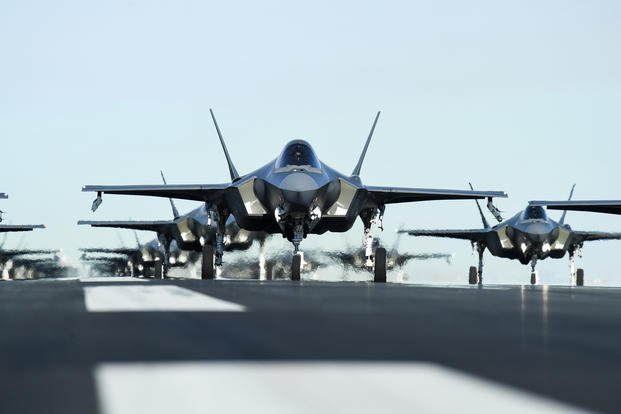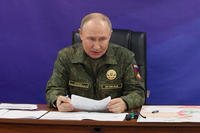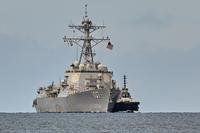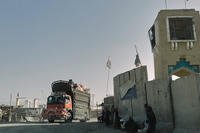For years, Congress has given the military services the option to buy extra F-35 Joint Strike Fighter stealth jets that were not in the original budget request. But some lawmakers say that practice may be coming to an end.
In a joint hearing April 22, members of the House Armed Services tactical air and land forces and readiness subcommittees cited long-term affordability concerns for the Defense Department's most expensive fighter jet program; they said that additional funding is unlikely for a program plagued with operational issues and cost overruns.
"Don't expect more money," said Rep. John Garamendi, D-Calif., chair of the readiness subcommittee. "Do not expect to have more planes purchased than authorized in the president's budget; that's not going to happen.
Read Next: B-1 Bomber Fleet Grounded Indefinitely Over Fuel System Problem
"I'm gonna take a deep breath and try to contain my anger," he added. "I don't really know where to start, because every single piece of this is problematic. Every single piece. The program is over budget. It fails to deliver on promised capabilities, and its [mission] capability rates do not even begin to meet the service thresholds. Industry's solution to many of these problems is simply to ask the taxpayers to throw money at the problem. That will not happen. The easy days of the past are over."
Rep. Donald Norcross, D-N.J., chair of the tactical air and land forces subcommittee, echoed Garamendi's concern.
"I would not support any requests for additional aircraft beyond what is contained in this year's president's budget request," he said. "[This subcommittee] has been supportive of this program in the past. But as we've said many times, we don't have unlimited resources as we chase this elusive affordability of the program."
Witnesses at the hearing included Diana Maurer, director of military structure and operations issues at the Government Accountability Office; Greg Ulmer, executive vice president of aeronautics for Lockheed Martin; Matthew Bromberg, president for military engines at Pratt & Whitney, a subsidiary of Raytheon Technologies; Lt. Gen. Eric Fick, program executive officer for the F-35 Joint Program Office; and Brig. Gen. David Abba, director of the Air Force F-35 Integration Office.
The Pentagon requested 79 F-35s in its fiscal 2021 budget request: 48 F-35As, the conventional takeoff and landing version of the aircraft, for the Air Force; 10 F-35Bs, the short takeoff and vertical landing version, for the Marine Corps; and 21 F-35C carrier variants distributed between the Navy and the Marine Corps, according to a report from Defense News.
Congress then added 17 more jets, for a total of 96.
During the hearing, lawmakers expressed displeasure with a number of outstanding issues, including ballooning sustainment costs, which are expected to exceed $1.2 trillion over the life of the program; spare parts shortages; and an engine shortage.
Bromberg, of Pratt & Whitney, which manufactures the fighter's F135 engine, revealed that engine costs will increase by 3% due to Turkey’s removal from the program.
Bloomberg News reported in February that there is a growing shortage of F135 engines.
Problems with existing engines are exacerbating the issue.
"There are two reasons -- COVID disruptions and [engine production] quality findings," Bromberg said of the engine delay. He cited "COVID, Turkey, learning curve disruptions" as lessons learned for how the company needs to better mitigate its engine and spares production.
In 2019, the Pentagon officially booted Turkey from the F-35 program over its purchase of the Russian-made S-400 surface-to-air missile system; as a result, the DoD also began phasing it out of the supply system.
Turkish industries produce roughly 1,000 parts for the F-35, including 188 associated with the engine, Bromberg said. It also produced items for the landing gear and fuselage.
"The Turkey suppliers were high quality, low cost; 75% of them have been [replaced by] new suppliers. Most of those are domestic here in the United States," he added. "We'll have the remaining 25% qualified by the end of the year."
In a new report published last month, the Government Accountability Office said it will likely cost $108 million to establish alternative suppliers. The Pentagon originally estimated it would cost $500 million to $600 million to do so.
As a direct impact of the engine shortall, Air Combat Command, which oversees fighter aircraft units, decided to scale back its 2021 air show requirements for the F-35 to ensure availability of jets for deployments and training.
-- Oriana Pawlyk can be reached at oriana.pawlyk@military.com. Follow her on Twitter at @Oriana0214.
Related: Stop Throwing Money Down F-35 'Rathole,' Top Lawmaker Says













